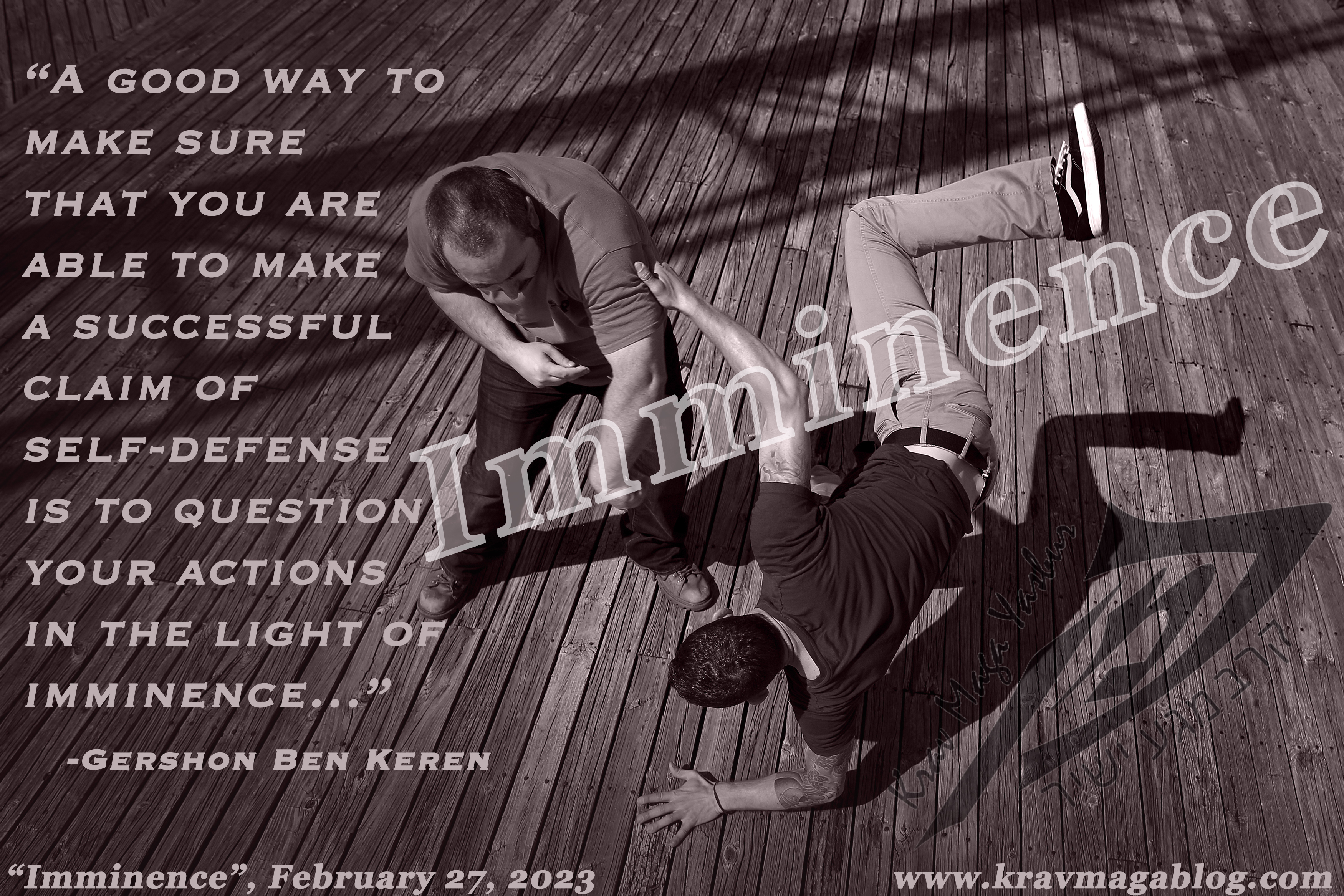Once when conducting an active shooter/killer training session, I started to describe the process of what to do (and what not to do), after a shooter had been brought under control, and separated from their weapon etc. As I was detailing the various steps and options that were available someone asked (and I paraphrase), “Why don’t you just shoot them? After all they were trying to kill you.” It’s not a stupid question, and it contains a logical argument, however it misses a fundamental element from a self-defense/legal perspective i.e., if the shooter has been secured and isolated from their weapon(s), are you in imminent danger? In the scenario we were working with an “improvised” team of co-workers had the active killer under control. Nobody – in that moment - was in imminent danger. Some may feel that it would be morally justified to shoot (execute) the killer, especially if they had shot and killed fellow co-workers etc. However in that moment, because nobody was in imminent danger, doing so could not be construed as an act of self-defense, and individuals don’t get to be either judge and/or jury, whatever their emotions may be telling them. It would be a different matter, that if in the course of attempting to subdue the shooter someone used lethal force by striking them with a fire extinguisher, because in that moment they were in imminent danger, and their life was at risk. In this article I want to look at the importance in imminence as it applies to making a claim of self-defense, because sometimes what we think is the “right” thing to do, may not be the legal thing to do. By understanding the importance of “imminence” to making a claim of self-defense we can make sure that we don’t suffer any negative legal consequences of our actions.
Many times, when I watch Krav Maga video clips of gun disarms, the technique and scenario, end with the person making the disarm, backing off, pointing the weapon at its original “owner”, and instructing them to get on the floor etc. It’s a morally satisfying vignette e.g., the aggressor has been dealt with and put in their place, and the person they tried to victimize has “defeated” them. Cue credits and theme music, because many people don’t seem to think beyond this point as to what happens next e.g., do the police turn up, immediately identifying the “new“ shooter as the “original” target etc. There may be contexts wherein it’s appropriate from a practical safety perspective to hold someone in place after disarming them, but it has many, many risks to it, and from a legal perspective can potentially jeopardize a self-defense claim i.e., the moment you step back and train the weapon on them, it becomes harder to make the claim that you are the one in imminent danger, in fact your original aggressor may now get to make that claim. Whilst from your perspective everything that occurred may seem to be one singular event, in the eyes of the law, the confrontation may be seen as a number of separate incidents, where at times it wouldn’t be deemed that you were acting in self-defense. In fact, the legal claim to who was acting in self-defense can switch hands over the course of a physical confrontation. This can seem confusing when someone else “started” the confrontation by sticking a gun to your head and putting you in imminent danger. However, the right to claim self-defense doesn’t stay with you to the end, regardless of what happens; when you are no longer in imminent danger and you continue the confrontation, you may in fact end up being seen as the aggressor.
In some regards this may seem crazy i.e., the person who initiated the fight, may end up getting to the make the “final” claim of self-defense, however the importance of imminence protects all parties in a fight, and can prevent excessive force from being used. For example if you were to throw someone to the ground who turns away, whilst you remain standing, ceteris paribus (all other things being equal), you are not in imminent danger; you also may have an opportunity to leave the incident. If you now start kicking the person in the head, it is likely that you will be found to have used excessive force; you were not in imminent danger and didn’t have a need to physically defend yourself by kicking the other party. Coming back to the active shooter scenario, where the killer has demonstrated their intent, and their ability to act on it, if you were kicking them in the head to render them unconscious, because they were crawling across the floor trying to reach a weapon this would be another matter because you are still in imminent danger. However, if you have been given no reason to believe that the person you threw to the floor has a weapon on them, that could put you in imminent danger, it is going to be hard for you/your attorney to justify your actions. Claiming that “they could have” had a weapon on them, isn’t reason enough to continue assaulting them.
A good way to make sure that you are able to make a successful claim of self-defense is to question your actions in the light of imminence i.e., if you are not in imminent danger, and can disengage safely do so etc. Disengagement reinforces your “innocence” in a situation, that is you didn’t want to be involved in a physical altercation or to use violence; at the first opportunity after defending yourself, when it was safe, you left.
Share:

Gershon Ben Keren
2.8K FollowersGershon Ben Keren, is a criminologist, security consultant and Krav Maga Instructor (5th Degree Black Belt) who completed his instructor training in Israel. He has written three books on Krav Maga and was a 2010 inductee into the Museum of Israeli Martial Arts.
Click here to learn more.

